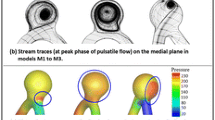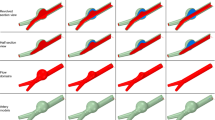Abstract
Our purpose was to identify and quantify hemodynamic factors contributing to the generation, proliferation, and rupturing of abdominal aorta aneurysms (AAAs) using a computational investigation of steady laminar and turbulent flow in AAA models. Steady laminar and turbulent flows were computed using the incompressible Navier-Stokes equations. Flow fields in symmetric shapes of different extents and degrees of expansion are presented first. Two representative cases of asymmetric AAAs are considered next: an aneurysm with an elliptic cross section and an aneurysm with preferential expansion in one direction. For symmetric aneurysms, parametric studies are presented. For asymmetric aneurysms, flow fields are computed only for high flow rates representative of systolic flow. For all cases, a recirculating flow region was found in the expanded part of the AAA. Recirculation is accompanied by a minor increase in pressure but a significant increase in wall shear stress. For cases where turbulent flow was considered, it was found that the recirculation zone diminishes but the computed wall shear stress reaches levels higher than laminar flow. The levels of wall shear stress reached in turbulent flow may cause lesions of the aneurysmal wall. The minor variation of pressure within the aneurysms with smooth expansions indicates that the structural properties of the arterial wall tissue may play a significant role for the generation and subsequent proliferation of the aneurysm. However, the high values of the wall shear stress in AAAs appear to be an important hemodynamic factor that may contribute to wall degeneration and eventual rupturing. The recirculating flow in AAAs may explain the generation of intraluminal thrombi. Furthermore, the asymmetry and complexity of the flow in asymmetric AAAs may explain the frequently observed asymmetric thrombi distribution.














Similar content being viewed by others
References
White FM. Viscous Fluid Flow. New York: McGraw-Hill, 1974
McDonald DA. Blood Flow in Arteries, 2nd ed. London: Edward Arnold, 1974
Ekaterinaris IA. Numerical simulation of incompressible two-blade rotor flow fields. AIAA J Propulsion Power 1998;14:367-374
Rogers SE, Kwak D, Kiris C. Steady and unsteady solutions of the incompressible Navier-Stokes equations. AIAA J 1991;29:603-610
Peric M. A finite volume method for the prediction of three-dimensional fluid flow in complex ducts. PhD thesis, University of London, 1985
Taylor CA, Huges T, Zarins CK. Finite element modelling of blood flow in arteries. Comput Methods Appl Mech Eng 1998;158:155-196
Ekaterinaris JA. Numerical investigation of dynamic stall active control for incompressible and compressible flows. J Aircraft 2001;38:71-78
Chorin AJ. Numerical methods for solving incompressible, viscous flow problems. J Comput Phys 1967;2:12-26
Merkle CL, Athavale M. Time-accurate unsteady incompressible flow algorithm based on artificial compressibility. AIAA, 1987, Paper no. 87-1137
Spalart PR, Allmaras SR. A one-equation turbulence model for aerodynamic flows. AIAA, 1992, Paper no. 92-0439
Wilcox DC. Turbulence Modelling for CFD. La Cañada, CA: DCW Industries, 1994
Humphrey AC, Taylor AMK, Whitelow JH. Laminar flow in a square duct of strong curvature. J Fluid Mech. 1997;83:509-527
Bengtson H, Bergqvist D. Ruptured abdominal aortic aneurysm: a population based study. J Vasc Surg 1993;18:74-80
Katz DJ, Stanley JC, Zelenock GB. Operative mortality rates for intact and ruptured abdominal aortic aneurysms in Michigan: an eleven-year statewide experience. J Vasc Surg 1994;19:804-817
Brown LC, Powell IT. Risk factors for aneurysm rupture in patients kept under ultrasound surveillance. UK Small Aneurysm Trial Participants. Ann Surg 1999;230:289-297
Nevitt MP, Ballard DJ, Hallett JW. Prognosis of abdominal aortic aneurysms: a population based study. N Engl J Med 1989;321:1009-1014
Nicolls SC, Gardner JB, Mesiiner MH, Johansen KH. Rupture in small abdominal aneurysms. J Vasc Surg 1998;28:884-888
Darling RC, Messina CR, Brewster DC, Ottinger LW. Autopsy study of unoperated abdominal aortic aneurysms. Circulation 1977;56(Suppl. 2):161-164
Fillinger MF, Raghavan ML, Marra SP, Cronenwett JL, Kennedy FE. In vivo analysis of mechanical stress and abdominal aortic aneurysm rupture risk. J Vasc Surg 2002;36:589-597
Fillinger MF, Marra SP, Raghavan ML, Kennedy FE. Prediction of rupture risk in abdominal aortic aneurysm during observation: wall stress versus diameter. J Vasc Surg 2003;37:724-732
Peattie RA, Asbury CL, Bluth El, Riehle TJ. Steady flow in models of abdominal aortic aneurysms. Part II: Wall stresses and their implication in vivo thrombosis and rupture. J Ultrasound Med 1996;15:689-696
Finol EA, Amon CH. Flow-induced wall shear stress in abdominal aortic aneurysms. Part I: Steady flow hemodynamics. Comput Methods Biomed Eng 2002;5:309-318
Stehbens W. Flow disturbances in glass models of aneurysms at low Reynolds numbers. Q J Exp Physiol 1974;59:167-174
Dexter D, Hoffman A. Steady flow through several aneurysm models. In: Kuklinski W, Ohley W eds. Proceedings from the 11th Annual Northeast Bioengineering Conference, March 14–15, 1985, Worcester, MA, pp 147–150
Taylor TW, Yamaguchi T. Three-dimensional simulation of blood flow in an abdominal aortic aneurysm: steady and unsteady flow cases. J Biomech Eng 1994;116:89-97
Author information
Authors and Affiliations
Corresponding author
About this article
Cite this article
Ekaterinaris, J.A., Ioannou, C.V. & Katsamouris, A.N. Flow Dynamics in Expansions Characterizing Abdominal Aorta Aneurysms. Ann Vasc Surg 20, 351–359 (2006). https://doi.org/10.1007/s10016-006-9031-1
Received:
Revised:
Accepted:
Published:
Issue Date:
DOI: https://doi.org/10.1007/s10016-006-9031-1




